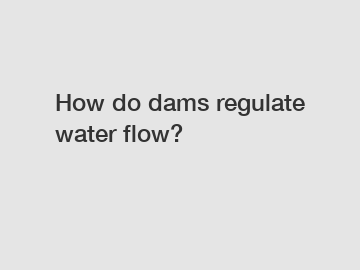How do dams regulate water flow?
Dams play a crucial role in regulating water flow in rivers and reservoirs. They can store water during times of excess and release it during times of drought or peak demand. By controlling the flow of water, dams help manage flooding, generate hydroelectric power, and provide water for agriculture, industry, and domestic use. In this article, we will explore how dams regulate water flow to meet various societal needs.
### Storage of Water.
One of the primary ways dams regulate water flow is by storing excess water during periods of high flow, such as heavy rainfall or snowmelt. This stored water can then be released gradually over time to maintain a steady flow downstream. By storing water in a reservoir, dams can prevent flooding in downstream areas by holding back the excess water and releasing it at a controlled rate.

### Release Mechanisms.
Dams are equipped with various release mechanisms that allow operators to control the flow of water. One common method is to use spillways, which are designed to release water when the reservoir reaches its maximum capacity. Spillways can be either controlled, where operators can regulate the flow of water, or uncontrolled, where water is released automatically once it reaches a certain level. Other release mechanisms include outlet works, which are pipes or channels that allow water to be released from different levels of the reservoir, and turbines, which generate hydroelectric power as water flows through them.
### Flood Control.
Dams are crucial for managing floodwaters by regulating the flow of water downstream. During periods of high flow, dams can hold back water in the reservoir to reduce the risk of flooding in downstream areas. By controlling the release of water, dam operators can prevent sudden surges in water levels and protect communities and infrastructure from the devastating effects of flooding. In addition to controlling the flow of water, dams can also help manage sediment and debris that can contribute to flooding by trapping them behind the dam.
### Drought Management.
In times of drought, dams can release stored water to maintain a consistent flow downstream and ensure a reliable water supply for agricultural, industrial, and domestic use. By storing water during periods of excess and releasing it when needed, dams help mitigate the impacts of drought by providing a steady water supply for communities and ecosystems. Dams also play a critical role in recharging groundwater and maintaining water levels in rivers and lakes during dry periods.
### Hydropower Generation.
Dams are important for generating hydroelectric power by harnessing the energy of flowing water. Water stored in the reservoir is released through turbines, which spin generators to produce electricity. By regulating the flow of water, dams can optimize the generation of hydropower to meet the electricity needs of communities and industries. Hydropower is a clean and renewable source of energy that reduces greenhouse gas emissions and dependency on fossil fuels.
In conclusion, dams are essential for regulating water flow to meet various societal needs, including flood control, drought management, hydropower generation, and water supply. By storing water during periods of excess and releasing it when needed, dams help manage water resources sustainably and efficiently. Contact us to learn more about how dams regulate water flow and contribute to the well-being of communities and ecosystems.
For more information, please visit Hydraulic Elevator Dam, Irrigation Inflatable Rubber Dam, rubber dam design for Myanmar.


